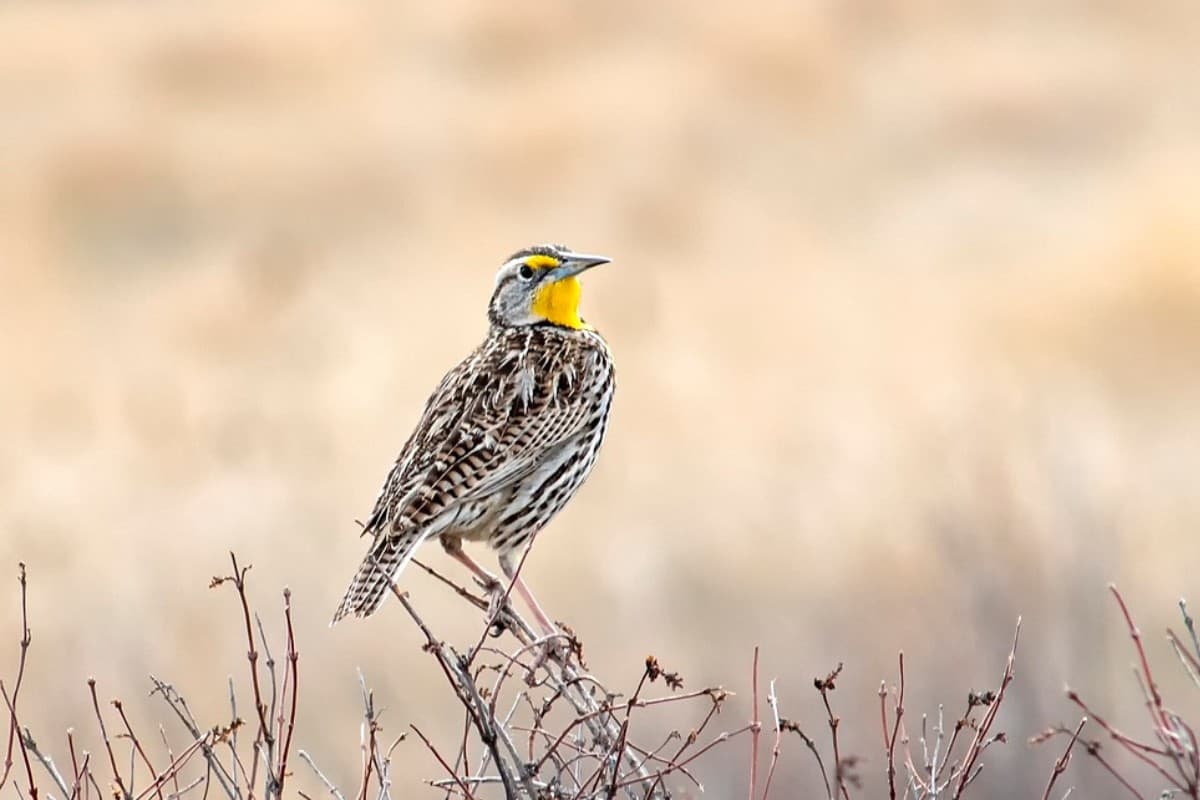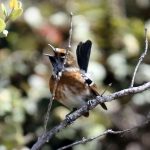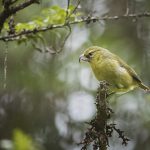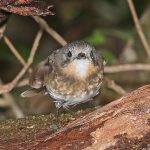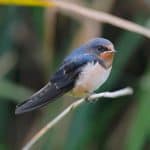Common Name: Western Meadowlark
Scientific Name: (Sturnella neglecta)| Size | Diet | Range in Hawaii | Status in Hawaii |
|---|---|---|---|
| 8.5 in. - 11.5 in. | seeds, fruits and insects. | Kaua'i | Least Concern |
The Western Meadowlark (Sturnella neglecta) is a beautiful and melodious bird species that is known for its distinctive yellow breast and melodic song. With its charming appearance and sweet melodies, this meadowlark is a beloved sight in its natural habitat.
Although it is not a native species to Hawaii, the Western Meadowlark has been established on the islands as a naturalized (non-native) resident for a long time. In this article, we’ll explore the fascinating world of the Western Meadowlark and learn more about its establishment in Hawaii.
Western Meadowlark
Appearance
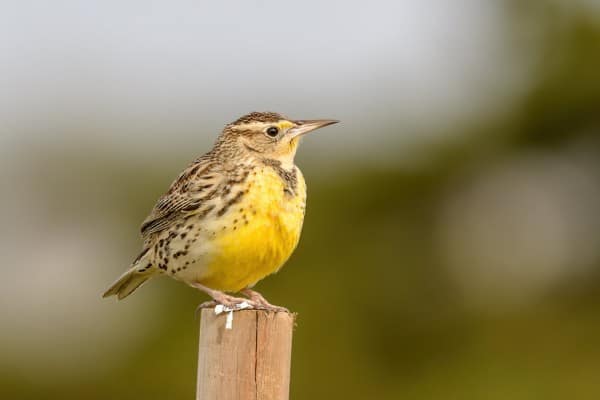
The Western Meadowlark is a medium-sized songbird with distinctive and recognizable features. It measures approximately 8.5 to 11.5 inches (21.6 to 29.2 cm) in length, from the tip of its bill to the end of its tail.
The bird has a stout body with a rounded head and a relatively short tail. It possesses a long, pointed bill, which is pale in color. The plumage of the Western Meadowlark is primarily brownish with a mix of streaks, spots, and mottling.
The upperparts are predominantly brown, while the underparts are lighter in color, ranging from pale yellow to bright yellow. The belly and throat often display bold black V-shaped markings.
One of the most striking features of the Western Meadowlark is its vibrant yellow breast with a prominent black “V” pattern. This distinctive pattern extends from the throat down to the upper breast. The black markings on the breast and throat serve as key identifiers for distinguishing the Western Meadowlark from other similar species.
Males and females share a similar appearance, although males may have slightly brighter and more extensive yellow coloring on their underparts. Juveniles have a more mottled appearance with less defined markings and a duller overall coloration.
Diet
The Western Meadowlark has a primarily insectivorous diet, although it is an omnivorous species and also consumes seeds and fruits. Insects make up a significant portion of its diet, especially during the breeding season when they provide a crucial source of protein for both adults and nestlings.
The bird forages on the ground, using its long, pointed bill to probe the soil and leaf litter in search of insects such as grasshoppers, beetles, ants, spiders, and caterpillars. It may also feed on small snails and earthworms found in the soil.
During the non-breeding season, when insects are less abundant, the Western Meadowlark supplements its diet with seeds and fruits. It feeds on a variety of grass seeds, weed seeds, and small grains. It may also consume berries, especially during periods when fruits are available.
Nesting
The Western Meadowlark constructs its nests on the ground, typically hidden in vegetation or tall grasses. Nesting occurs during the breeding season, which is generally from spring to early summer.
The female takes the primary responsibility for building the nest. She creates a cup-shaped structure by excavating a shallow depression in the ground, lining it with grasses, leaves, and fine plant materials, and weaving the materials together to form a sturdy foundation. The nest is often well concealed and positioned in a location that provides some protection from predators and the elements.
Once the nest is constructed, the female lays a clutch of eggs. The number of eggs laid varies but typically ranges from 3 to 6. The eggs are pale gray or greenish-white with brown or gray speckles, providing camouflage within the nest.
Both the male and female take turns incubating the eggs, which lasts for approximately 12 to 14 days. Once the eggs hatch, both parents participate in caring for the nestlings.
They provide food by foraging for insects and other small invertebrates, which they deliver to the nest. The nestlings grow rapidly, and after about 10 to 12 days, they fledge and leave the nest.
After fledging, the young birds are still dependent on their parents for a period of time as they learn to forage and become independent. The Western Meadowlark may raise multiple broods in a single breeding season, with subsequent nests built and eggs laid after the successful rearing of the previous brood.
Behavior
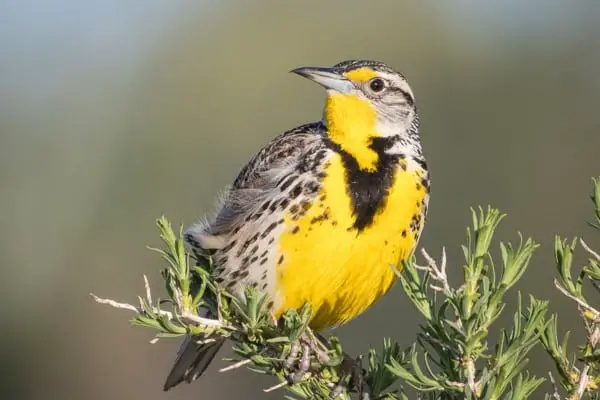
The Western Meadowlark exhibits a variety of fascinating behaviors that contribute to its survival and communication within its habitat. Males are known for their melodious and distinctive songs, which they use to defend their territory and attract mates.
They perch on elevated spots or fence posts while delivering their beautiful flute-like series of whistles. Territoriality is a significant aspect of their behavior, with males establishing and defending their territories during the breeding season using songs, visual displays, and aggression to ward off intruders.
When it comes to foraging, Western Meadowlarks primarily search for food on the ground. They use their long, pointed bills to probe the soil, looking for insects, spiders, and other invertebrates. They are opportunistic feeders and may also consume seeds and fruits, particularly during the non-breeding season when insects are less abundant.
The Western Meadowlark’s ground-nesting behavior is another noteworthy aspect. They construct their nests on the ground, concealed within vegetation or tall grasses, providing some protection from aerial predators. However, this nesting strategy also exposes them to risks from ground-dwelling predators.
During courtship and territorial disputes, Western Meadowlarks engage in flight displays. These displays involve swooping flight patterns, wing-fluttering, and acrobatic maneuvers, serving as communication signals to rivals or potential mates.
As migratory birds, Western Meadowlarks undertake seasonal migrations. They breed in northern regions and migrate southward to more temperate areas for the winter. They can travel both short and long distances, with some populations migrating as far as central Mexico.
While Western Meadowlarks are generally solitary birds, they form monogamous pairs during the breeding season. They defend their territories and communicate through vocalizations and visual displays. Outside of the breeding season, they may gather in loose flocks or small groups during migration or while foraging in suitable habitats.
These behavioral characteristics, including their enchanting songs, territoriality, ground foraging, ground-nesting, flight displays, seasonal migration, and social behavior, contribute to the Western Meadowlark’s survival and reproductive success in its grassland and meadow habitats.
Habitat
The Western Meadowlark is primarily associated with open grasslands, meadows, prairies, and agricultural fields throughout its range. It is a bird species that thrives in habitats with a mixture of grasses, scattered shrubs, and some open areas. These habitats provide the Western Meadowlark with suitable foraging opportunities, nesting sites, and areas for territorial displays.
They are commonly found in areas with moderate to tall grasses, where they can forage on the ground for insects and seeds. These grassy habitats offer the birds ample food resources and cover. They may also inhabit pastures, hayfields, and agricultural fields, taking advantage of the open spaces and abundant insects attracted to these areas.
The presence of some taller vegetation or scattered shrubs within the habitat is important for the Western Meadowlark, as these features provide perches for singing and territorial displays. Additionally, taller grasses or vegetation can offer some protection and concealment for their ground nests.
While Western Meadowlarks prefer open grassland habitats, they may also utilize other open areas, such as prairies, meadows, and even roadside edges. However, they generally avoid densely forested areas or habitats with a lack of suitable grassy cover.
Range
The Western Meadowlark, a bird species introduced to Hawaii, has established itself primarily on the island of Kaua’i. The initial introduction took place in the 1920s and 1930s, with additional releases by the Hawaiian Board of Agriculture and Forestry (HBAF) for insect control purposes. Over the years, the Western Meadowlarks spread across Kaua’i, inhabiting pasture lands and open areas.
On other Hawaiian islands, including Ni’ihau, O’ahu, Moloka’i, Maui, and Hawai’i Island, the presence of Western Meadowlarks after their introductions in the 1930s is poorly documented, with limited records and unsubstantiated sightings.
Conservation Status

The Western Meadowlark is currently listed as “Least Concern” by the International Union for Conservation of Nature (IUCN). This status indicates that the species is not facing imminent extinction or significant population declines on a global scale.
Interesting Facts
1. Beautiful song
The Western Meadowlark is renowned for its melodious and distinct song, which is often described as a flute-like series of whistles. Its song is considered one of the most iconic sounds of North American grasslands.
2. State bird
The Western Meadowlark is the official state bird of six U.S. states: Kansas, Montana, Nebraska, North Dakota, Oregon, and Wyoming.
3. Vocal mimicry
While the Western Meadowlark has a unique and recognizable song, it can also mimic the sounds of other bird species and even human-made sounds.
4. Territorial birds
During the breeding season, Western Meadowlarks establish and defend territories. They use vocalizations, visual displays, and aggressive behaviors to protect their nesting sites and attract mates.
Frequently Asked Questions
1. Are Western Meadowlarks monogamous?
Yes, Western Meadowlarks are monogamous during the breeding season. Males and females form pairs and participate in nest building, incubation, and caring for the young.
2. Can Western Meadowlarks mimic other bird species?
Yes, Western Meadowlarks have the ability to mimic the sounds of other bird species, as well as human-made sounds.
3. Are Western Meadowlarks found in Hawaii?
Yes, Western Meadowlarks have been successfully introduced to the Southeastern Hawaiian Islands, particularly on the island of Kaua’i. They were brought to Hawaii in the 1920s and 1930s and established populations on Kaua’i. Attempts to introduce them to other Hawaiian islands have been less successful.
4. How long do Western Meadowlarks live?
The average lifespan of Western Meadowlarks in the wild is typically around 5 to 6 years. However, with favorable conditions and survival, some individuals have been known to live up to 10 years or more.
